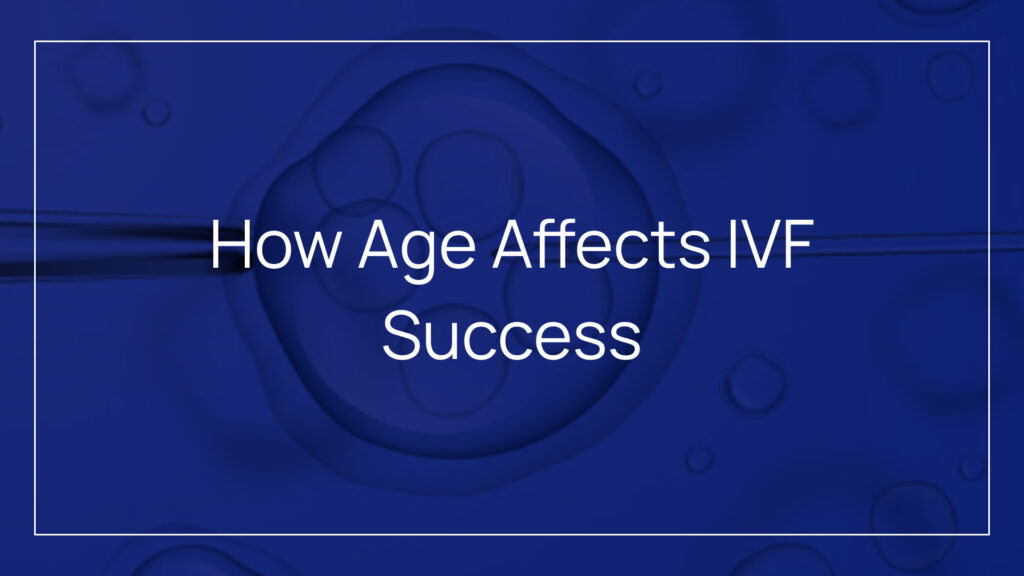How Age Affects IVF Success

Age affects IVF success by influencing both the quantity and quality of a woman’s eggs. As women age, the number of eggs stored in the ovaries drops. More importantly, the likelihood of those eggs developing into healthy embryos also decreases.
This shift usually becomes noticeable in the early thirties and accelerates after 35. While IVF can help collect multiple eggs at once, it does not improve the quality of eggs retrieved. Even with perfect lab conditions, the body’s natural egg aging process cannot be reversed or bypassed.
Most fertility specialists look at age first when evaluating IVF potential. It’s not only about how many eggs can be retrieved, but also whether those eggs are genetically stable and capable of producing a viable pregnancy.
Egg Quality Declines With Age And Limits IVF Potential
The quality of a woman’s eggs naturally declines with age, which directly affects the development and implantation success of embryos during IVF. This decline is tied to the time eggs spend in the body, not lifestyle factors alone. A 40-year-old woman is using an egg that has been inside her body for four decades.
Younger eggs are more likely to develop into healthy embryos with normal chromosomes. In contrast, eggs from women over 38 have a higher risk of forming embryos that stop developing or fail to implant. That’s why age-related egg quality is one of the top reasons IVF becomes less effective later in life.
This biological limitation is why IVF outcomes differ greatly between women who are the same age but have different egg quality profiles. It’s not enough to have eggs; they need to be functional and genetically balanced.
IVF Treatment Strategy Shifts With Age
The approach to IVF treatment becomes more specialized as age increases. Clinics often modify stimulation protocols, adjust transfer timing, and apply embryo selection strategies that are more precise for women over 35.
Older patients are usually given a plan that aims to maximize the number of eggs retrieved in each cycle. This helps increase the odds of finding a healthy embryo. In many cases, IVF clinics also recommend freezing embryos for later transfer, giving time to assess which embryos have the highest potential for success.
Some women undergo more than one cycle back-to-back to collect enough eggs for future use. This is often called egg banking or embryo accumulation, and it’s a strategy focused on increasing chances over time, not just per cycle.
At the same time, IVF for older patients may include a shift from fresh embryo transfers to frozen transfers, since this allows for better cycle planning and uterine preparation. These choices are made based on both age and how the patient’s body responds to stimulation.
IVF Success Rates Decline As Age Increases
IVF success rates drop significantly with age, and this is supported by long-term fertility clinic data. In women under 35, each IVF cycle has a much higher chance of resulting in a live birth. After 35, those chances fall steadily each year.
The following table shows the general pattern of success:
| Age Range | Average Eggs Retrieved | Chance of Healthy Embryo | Live Birth Rate per Cycle |
|---|---|---|---|
| Under 35 | 10–15 | High | 45–50% |
| 35–37 | 8–12 | Moderate | 35–40% |
| 38–40 | 6–10 | Low | 20–30% |
| 41–42 | 3–7 | Very Low | 10–15% |
| 43 and older | 2–5 | Rare | Below 5% |
These numbers reflect not just the quantity of eggs retrieved, but the likelihood that at least one embryo is healthy enough to grow into a full-term pregnancy. While these are averages, they show that age remains the most powerful factor in predicting IVF success.
Some Adjustments Can Improve IVF Results In Older Women
Even though egg quality cannot be reversed, some changes in IVF preparation and execution can improve the chance of success for older women. These adjustments don’t fix age-related limitations but help optimize what’s possible.
One method involves using supplements like CoQ10 several months before starting treatment. While the science is still developing, some fertility experts believe this may support the energy needs of aging eggs.
Another important shift is in cycle planning. Patients over 38 are often advised to prepare for multiple retrieval cycles. Rather than expecting results from one try, the focus is on increasing the overall number of embryos collected across several attempts.
Personalized timing of embryo transfer can also be helpful. In some cases, the uterine lining may not be receptive at the exact moment a standard transfer is done. Adjusting timing based on hormone tracking can make a real difference when embryo quality is not the only issue.
Final Thoughts On Age And IVF
Age shapes almost every part of the IVF process, from how the body responds to medication, to the number and quality of eggs, and even how embryos grow. As the reproductive system changes over time, IVF success becomes less predictable and requires more strategic planning.
Still, understanding the role of age, egg quality, embryo viability, and personalized treatment helps set realistic expectations. Women considering IVF after 35 benefit from early testing, well-structured timelines, and a willingness to adjust strategies based on results.